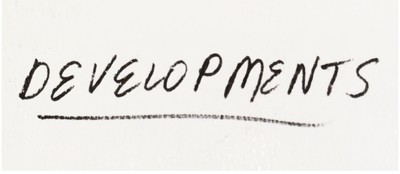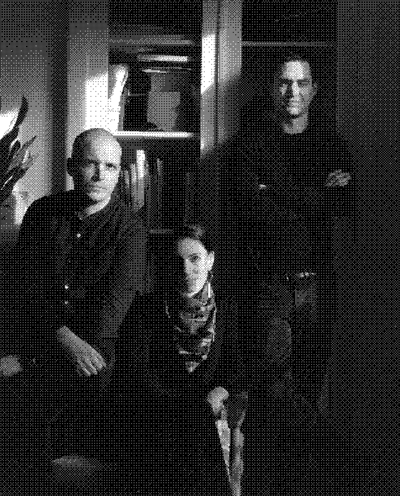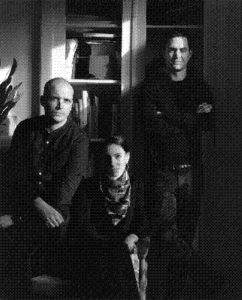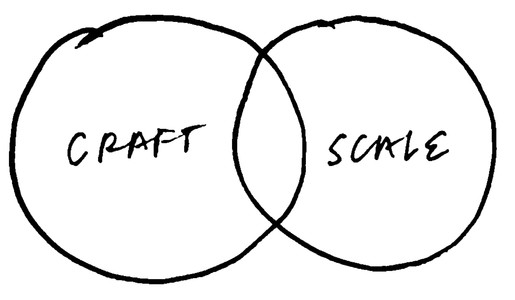Hi, Leo and Felipe. Could you please introduce yourselves?
I’m Leo Porto, co-founder of PORTO ROCHA — the “PORTO” in PORTO ROCHA. I’m a Brazilian Graphic Designer and Creative Director from Rio de Janeiro, raised in São Paulo, and living in New York for 14 years now. I’ve been a designer for as long as I can remember—I studied graphic design, worked at various studios and agencies, and now run PORTO ROCHA with Felipe.
FR
I am pretty much the same thing, but I’m the ROCHA part.
I’m also from Brazil, originally from São Paulo.
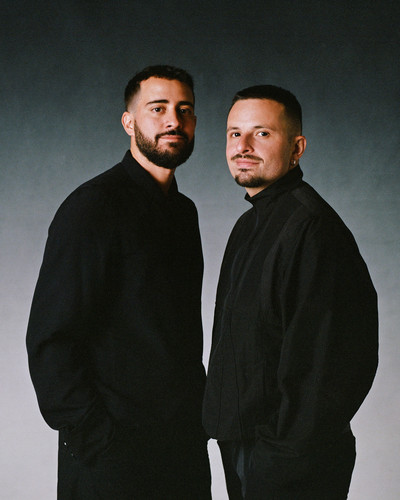
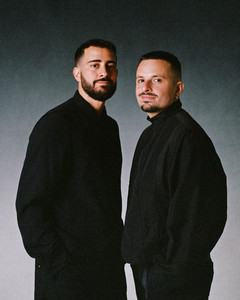
Leo Porto and Felipe Rocha by James Emmerman, 2024
Did you know each other before moving to the U.S. or did you meet in New York?
We knew each other from Brazil—we were Twitter friends actually—but we officially met in person in New York.


Tweet from Felipe Rocha to Leo Porto before they met in person which (“Hey, congrats man. It’s always cool to find Brazilian designers with beautiful work here.”), 2014
How do you present PORTO ROCHA now?
In short, we are a strategy and design agency.
FR
For a long time, I would say studio, and then Leo would get mad with me, saying I need to say “agency” in front of clients. And now, finally, I’m used to saying agency. But deep inside, I’m still thinking “studio”.
LP
Yes, in many ways we are still a studio in spirit, but we say agency because I think it’s a more accurate representation of our size and the scale of the work we do.
And also, because you integrate strategic work, which is often the main difference between independent studios and agencies.
That’s a good point. I guess we can say we are a full-service design agency because we have our strategy team, our brand team, motion, 3D, and interactive design all in-house. Of course sometimes, depending on the size of the project, we collaborate with other people and we outsource some tasks, especially for production, but most of the work we do is done in-house.
What’s your current state of mind?
This is the last week of work for the year, we are flying back to Brazil on Sunday for holidays, so overall, I’m tranquil.
LP
I feel pretty good, but also a bit tired from a very intense year. 2024 was overwhelming. Full of ups and downs and a lot of unpredictable curveballs, both globally on a political level but also on an industry level. Despite all of that uncertainty ahead, we are ending the year on a more optimistic note, I hope.
From the outside, it seems like PORTO ROCHA has had an amazing year as well in terms of growth. But you’ll tell us more about this, I guess, if we go back to the beginning of your career and your studies, or even before. What got you into graphic design and art direction?
For me, it started really, really young. Back when I didn’t entirely understand graphic design, I already had an inclination towards art and most things creative. When my family got me a computer, I must have been nine or so, I started playing with image-making software, not really knowing exactly what I was doing. I started creating invitations for friends and family, and event flyers. A few years later, I got my hands on (pirated versions of) Adobe Flash and Photoshop and learned through online tutorials. Design was still a niche discipline in Brazil (and many parts of the world, actually). So the most sustainable way to be a designer was to work at an advertising agency. I naturally enrolled in a marketing program in Brazil, but at the last minute decided to venture abroad to the School of Visual Arts (SVA) in New York. I did one year of advertising, didn’t love it and then switched programs to graphic design. At that point I had already started doing design internships over the summer and that’s how I got into the field.
FR
I come from a very poor neighborhood in São Paulo, Brazil. I didn’t know design was a thing back then. I was thinking about doing advertising because advertising was a profession that was kind of creative, but you could still make money. Then, I applied for a local public technical education program focused on Communication Design and luckily, I got accepted. That’s when I found out about design, really. Thanks to that, I got my first job in the field, which I used to pay for college. A year later, I was accepted at Fabrica (Benetton’s Creative Center) to work for Colors Magazine in Treviso. That experience really changed my life because it was the first time that I traveled abroad, the first time that I had to speak in English with others, and it was where I met a lot of interesting people. Wait, I’m actually wearing a Fabrica T-shirt today!
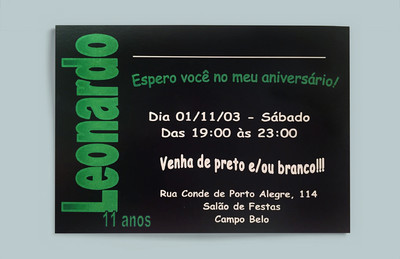
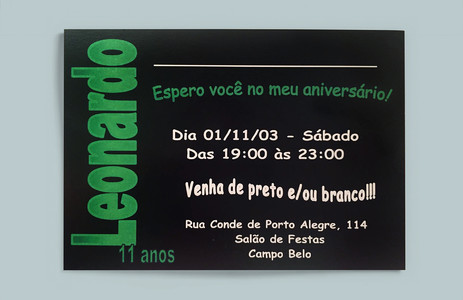
Leo Porto’s 11th birthday invitation, featuring Comic Sans, 2003
How did it change your life?
I don’t know, just going out of my bubble. If you are born in Brazil and if you really don’t have the conditions to study, travel and meet people, it feels impossible to work in design. I found myself working for a magazine that was so iconic back in the days and this opened my eyes to so many other possibilities.
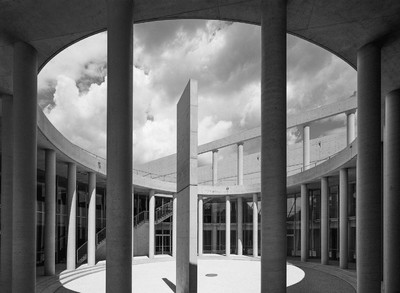

Fabrica Building in Treviso where Felipe Rocha worked as a graphic designer for Colors Magazine
And you, Leo, did you have a similar moment, like a realization?
To me, it was the experience of going to college in New York and realizing that design was not just a viable path forward, but an entire industry I could thrive in. Again, coming from Brazil, I had this almost idealized idea of what the US or Europe would be like. In a way it was (design was more valued and recognized) but in many ways it wasn’t. It sounds weird to say that now, but back then, I used to think everything from abroad was better and that I would have a hard time fitting in. And when I started doing internships here, I realized I was just as good as they were. I realized there were no magic formulas or design superheroes, and that I could do it too.
FR
I had a similar experience, but my realization didn’t come as naturally. I remember when I was at Fabrica, I was always trying to copy the style of my European friends and try to do designs that looked like they were made in Europe. That’s weird to say, but as a Brazilian, I wanted to fit in. It took me a while to understand that what’s special about the work we do is that we come from a place with different references, different backgrounds and it took me a while to understand the value of this actually.
LP
The biggest shift for us—and for most Brazilians—is recognizing our own potential and worth. As a designer, we are too often positioned under someone who holds the creative power, limiting you to a mere executor of ideas. In an ad agency, where design isn’t the protagonist, you’re seen as a tool—brought in to make things look good while creative directors and strategists shape the larger vision. I’ve always believed that as a designer, we are inherently strategic and we have more to offer than most care to recognize. This is why our designers participate in our strategy meetings, workshops and client presentations. One of our mantras at PORTO ROCHA is: designers should have a seat at the table.
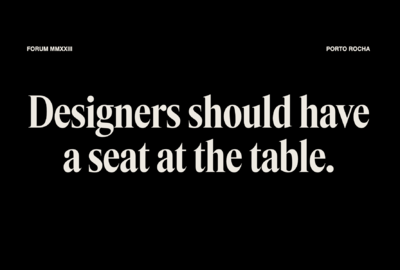
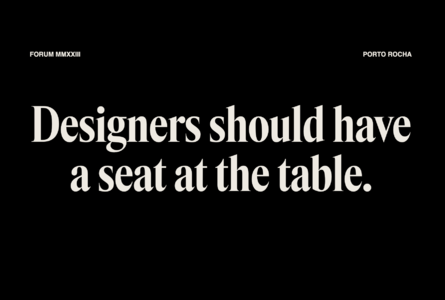
Slide from PORTO ROCHA’s talk on collaboration at FORUM, Montreal 2023
It’s funny because we interviewed Eike König, founder of Hort Studio in Berlin, and they’ve got a motto which is “not a client’s execution tool”. Was it during your studies or your first experiences you got rid of any possible imposter syndrome?
I guess I’ve had the opposite experience, because I didn’t get rid of imposter syndrome — but actually developed it as time passed. I didn’t struggle as much with imposter syndrome when I was a student, probably because I didn’t feel that pressure because no one was watching. But as I started achieving some success in the industry I definitely found myself asking, “do I deserve being here? Have I done enough? Am I good enough?”—and even more so now, with increased attention on my work, public reviews, and industry scrutiny—I totally felt the weight of meeting the high bar that I’ve established for myself, as well as the bar the industry has set for us. On the other hand, a lot of our strength comes from our desire to prove ourselves — and at the same time proving people wrong. I think growing up gay made us want to prove ourselves even more, and for us it gave us that fuel to push through.
FR
In my case, I always had impostor syndrome and I still do sometimes, but I treat that with therapy. So that’s the way that I go about it.

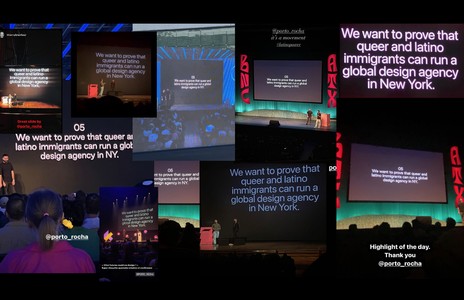
Collage of images taken by audience members during various talks of thier slide
When did you decide to found PORTO ROCHA? What happened between the end of studies and founding PORTO ROCHA?
We met almost 10 years ago. We started dating, living together, and eventually freelancing together too. We both had demanding full time jobs, so we had very limited time for freelance — working together was a way for us to be more efficient, bouncing ideas off each other and getting work done so we could spend time together. It started with smaller projects like art books, events and small brands and gradually grew to become PORTO ROCHA.

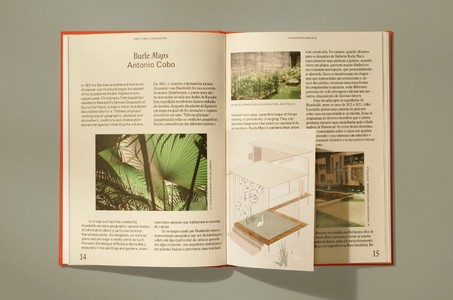
A spread from the book Emotional Landscapes, one of PORTO ROCHA’s first freelance projects together.
When you say you were freelancing together, you were always selling yourselves as a duo?
We had our own thing going on but eventually we agreed to say we were exclusively working as a duo. It was mostly because otherwise we would not get to see each other as much. People say “don’t mix dating and working”, but it ended up working for us. We complemented each other’s work and we got things done faster, so it felt like a win win for us.
FR
There was a shift at some point though, our projects started to get more and more complex so we had to decide whether to keep freelancing on the side or officially open the business together. The way PORTO ROCHA started was very gradual, very spontaneous. And in 2018, we decided to make it official. We opened an Instagram account and an LLC. As immigrants in the U.S. we also had to understand the implications of opening a business and changing our visa status, but besides that, it was very straightforward.
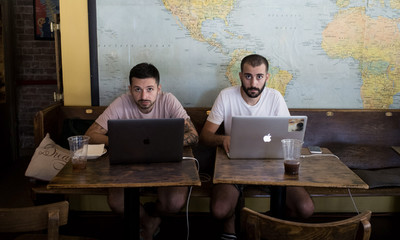
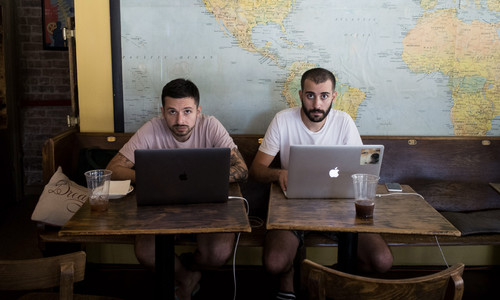
Leo Porto and Felipe Rocha from their early days of working together at Atlas Café in Brooklyn, 2016
Felipe, you mentioned this day when you said “let’s go for it, we want to become a big studio”. Was there a specific intuition?
I don’t think we ever wanted to be “big”. We were always thinking: “what’s next?” but short-term “next”. We were laser-focused on the projects we had to work on and the short term goals of the studio from a business perspective. And I think that’s how we still go about the studio today.
LP
Exactly. We weren’t thinking where we would be in three, five, ten years. Interestingly enough, I think this is what allowed us to grow pretty fast because we were mostly focused on the work — growth was just a consequence. Of course as we grew we also hired more Project Managers, Producers and Operation people, which is essential for keeping everything running smoothly.
To sum it up, this is what has driven us since day one: doing great work, working with great people, and fostering a great work environment.
You celebrated your fifth birthday as PORTO ROCHA. You’re around 30 people now. Growing that size in five years is quite amazing. One question about creativity: what were your creative references when you started freelancing 10 years ago?
I don’t know how to answer that question, to be honest. I guess it is a combination of everything around us, plus everything we have absorbed and experienced until now. I feel like we are all like sponges. And our work is a reflection of those combined perspectives and learned experiences from us two and the other 28 people who are bringing their ideas to the table. We also do a lot of research to understand our clients, their audiences and their environments. We don’t look that much at the design industry for creative references. It’s kind of a cliche answer, but it’s true.
FR
I always struggle with this question because I wish I had a more romantic answer, like “I always look at art”, but I don’t think that’s the reality. I think it’s always case by case, and it has been like that since we started. Each project has their own references. We try to look at unexpected references and inspirations, but it’s not like just one category.
Does sound like more of a strategist answer! I’m not a designer. I’m more of a strategist. But my references were always in literature and music but it’s very interesting to see if some have evolved. Obviously along the way you make new ones and you meet new inspiring figures.
Definitely. In a way, it is often a reflection of what you’re living, what’s happening in your life at the moment. I remember before starting PORTO ROCHA, I worked at Spotify for over two years, I have never listened to as much music as when I was working at Spotify, and it was reflected in my work. In the same way, we are rebranding art institutions at the moment and, for that reason, I’m much more interested in art currently.
LP
Your point about Spotify is interesting because it goes back to what we were saying earlier about our creative references. When I started working with Felipe, my perspective changed a bit. I started asking myself “where does my job start and where does it end?” We were excited to be thinking more widely and deeply about the whole universe we were building around brands, beyond traditional elements, systems and rules. Which is why our discipline is way more cross-functional now, in favor of more contextual, nuanced brand expressions that react to people and culture.
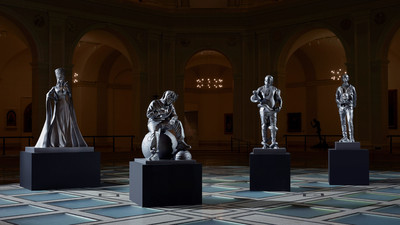
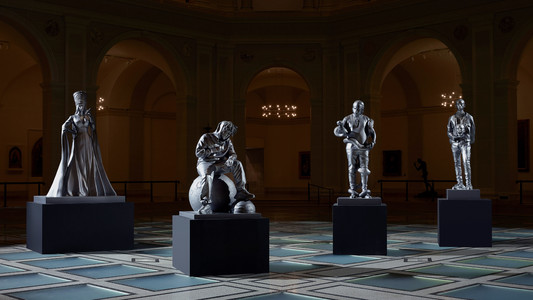
Spotify’s Pantheon exhibition for RapCaviar at the Brooklyn Museum, 2017
You mentioned you were nearly always working together as a duo. Is it still the case, or now do you have to handle projects separately?
We handle projects separately now, for the most part. About two years ago we decided to separate the projects because our schedules were too packed and it became overwhelming for us to be both present in every project.
Having worked together for more than 10 years, have you been thinking about how to maintain your level of creativity now that you’re also leading a business, having clients to handle?
We have a more balanced lifestyle in a way. Although the studio grew a lot, we are finally able to work a little bit less. In the first two years of the studio, Leo and I were working so much, every day, weekends, non stop. Finally we are at a point where it’s healthier.
LP
We still work an insane amount compared to a typical 9-to-6 schedule, but that’s part of being business owners. We rarely need to work on weekends nowadays, which helps us maintain our sanity and our creativity. But more importantly, we rely on our team’s creativity and unique perspectives they bring to the table. If it was just Felipe and I, we would have run out of fuel.
FR
Right, we are finally not the “cool kids” in the team anymore and what inspires me the most now is learning from the youngest designers, and it’s so cool!
So you ended up being just like creative directors in an agency.
I’ve said before I would never become “just” a creative director, but I guess that’s exactly where I’ve ended up. Honestly, I think it’s a healthy evolution—this industry is incredibly demanding and it would be crazy to think we could carry it all ourselves for this long, at the level of excellence we expect. One of my biggest concerns about starting my own studio is longevity—staying creatively stimulated and relevant over time is tough. The traditional model of a “design hero” leading a team of followers feels outdated. Today, you have to stay deeply connected to culture, technology, and insanely rapid change. Without a young, dynamic team to help absorb and adapt to these shifts, you risk becoming obsolete. And that’s something we are very conscious of.
FR
But it goes both ways. It’s also nice to be inspired by older people. I don’t think there’s one generation that has all the answers. And what’s nice is to have that exchange and be open.
In terms of strategy you mentioned you were growing very organically at the beginning, but at some stage, have you got some business strategy inspiration or references in mind?
We both worked at several studios and agencies throughout our career. I worked at Pentagram and at Chermayeff & Geismar & Haviv, a legacy studio, they are one of the founding fathers of American modernism, and they were going to work at their studio until their late 80s. I also worked at Mother Design, which is a division out of an advertising agency focusing on design. And then I worked at Collins, which is an independent design agency and consultancy led by Brian Collins. So I witnessed all these different models and, consciously or not, I absorbed what, in my opinion, was working and also took note of what I thought could be done differently. We don’t come from a business background at all, we were true graphic designers. But I think both of us have very strong intuition and make decisions based on what makes sense to us. Our first hire, Nick Schroeder, came in as Project Manager, then quickly became Operations Manager, Operations Director, and helped take care of more of the business side of things. And then we grew our project management team, our operations team, and brought in financial advisors. We have a relatively robust business team that helps alleviate the burden of running the business and gives us more time to focus on the creative side.
We describe ourselves as right in the intersection of design and culture, and business and strategy, somewhere in between a design studio and a strategy consultancy. On the one hand, small design studios are more nimble and can deliver high-caliber design and craft. On the other hand, big agencies and consultancies take on large projects but from a design perspective, the output is often lacklustre. We try to do it in a way that there’s no compromise: sacrificing neither the quality of design nor the strategic rigor needed for complex brand challenges.
Besides the places I’ve worked at, some references that come to mind in terms of that interesting combination of rigor and play; strategy and design are probably 2x4, Studio Dumbar, OK-RM, Zak Group.
FR
I think a strategy is only good when it’s actionable, when strategy turns into design and is translated in the real world. A lot of the time my frustration in previous experiences was when I saw beautiful decks with beautiful words, but it was really hard to see that strategy applied in the project in a way that is tangible for everyone.
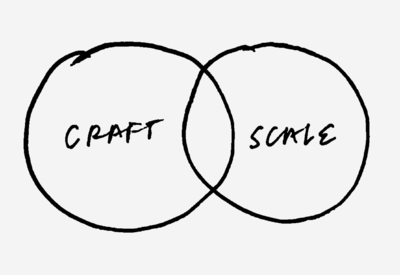

PORTO ROCHA’s sweet spot rests between craft and scale
It reminds me that at the beginning in the advertising agency in New York at the time of Mad Men, the copy was separated from the art direction and there was not even a real beginning. Then William Bernbach from DDB put the art directors and the copywriters together to add the image, ideas and words at the beginning of the process. Nowadays, most agencies still follow this model but the strategist works before, then he arrives and briefs. I think everybody should be working together all the time and they would understand each other’s jobs.
For sure, that’s why we involve designers in the strategy phase of work as well. Of course, the strategists are leading the process, but designers are still a part of it and inputting how they think could influence the next phase of work. The same way we bring strategists and copywriters into the design phase of work. That’s something that we feel pretty strongly about. If you look at our round one presentations, we don’t use any Lorem Ipsum or no placeholder copy. All of our mockups have text, written specifically for that context. And it takes the work to another level where there’s an intention behind what’s being said and it’s not just about looking at visuals.
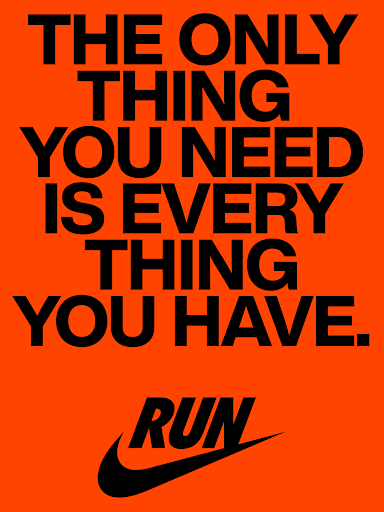

Visual and verbal identity by PORTO ROCHA
After five years, you now have enough experience not to think organically about the next two months like you were doing at the beginning. Now, how do you envision things for the next three years?
Another hard question to answer, but I don’t think we want to grow just for the sake of growing. We want to grow so long as we are able to work on projects and opportunities that continue to excite us. We definitely want to keep developing our strategy department. Also, we put a lot of effort in integrating interactive and motion with brand design over the last two years and expanding our interactive and product design capabilities. And I don’t think there is one single vision for the next three years. It’s more about keeping doing the work that we are doing and being conscious of the quick development of AI tools. I also think there’s a lot of potential to work with different markets besides the US and Latin America which we already are familiar with.
LP
I totally agree with Felipe. I think that’s the toughest question for us because we grew very organically. We focused on those two pillars that I talked about earlier: doing great work and working with great people, growth was a consequence. Of course, now that we are bigger, we also have to think about how we sustain the business without compromising the creative quality of the work, which, I think, is the biggest challenge for any studio or agency and is probably why huge agencies and conglomerates struggle to maintain the quality of design. We want to continue doing what we are doing and if we have enough demand, we can grow. If not, we are happy to be the same size. Growth was never a priority for us, it was just a consequence.
And you are independent at the moment. Is your plan to maintain that independence or at some stage to think about external investors?
Never say never, but I think for now we are planning to remain independent.
LP
Yes, we are happy being independent, but as Felipe said, never say never.
How do you handle business development? Is there someone who’s responsible for that? Have you handled it over the years and how do you handle it now?
To be honest, it hasn’t changed all that much over the years, it has always been very organic. We basically get requests from three main sources: connections that we’ve made throughout the entirety of our lives; previous clients that return for new projects or extensions; and cold emails that show up in our business@portorocha.com inbox. Nick Schröder, our Managing Director, oversees new business and is the main point of contact for all of these.
But I think there is an important distinction I’d like to make which is that throughout our careers, we’ve built many relationships that eventually became new business leads, but we never had the intention of these becoming business relationships. Otherwise it can sound like we love networking, which is not really the case, at all. We don’t really go to networking events but instead we’ve inadvertently done a lot of networking just by working and hanging out with people throughout our lives.
FR
For example, our five year party was a big celebration but was also part of our new business strategy. We love to host events, to party and have people around, but business networking is never the first goal. I remember, a few months ago, we got a new client because we were having a happy hour in our studio and this person was invited by a mutual friend. And six months later, this person wrote to us saying how she liked our vibe and our work. But my point is that you never know when you’re going to do a new business. And I think that’s how we operate.
LP
Agree. But at the same time, now that we are bigger, we have to continue investing in things that help get our name out there, doing talks all over the world and breaking out of the graphic design bubble so we are top of mind when clients are looking for an agency to collaborate with.
FR
At the end of the day I think the best new business strategy we have is to publish our case studies regularly, make sure our work happens in real life and focus on the people we work with.
Every project we share is an opportunity for people to remember that we exist, as a studio and as a body of work.


PORTO ROCHA’s Five Year Anniversary party in Brooklyn, 2024
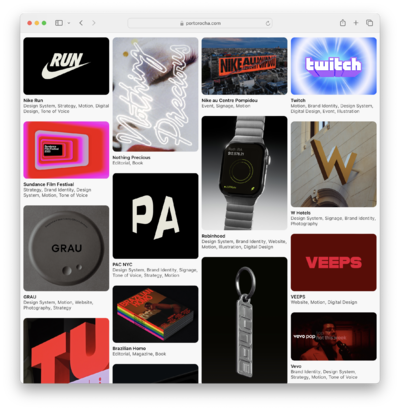
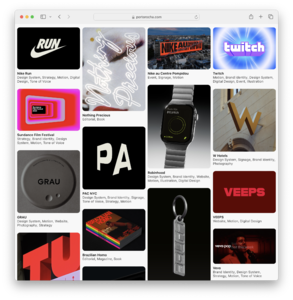
Project overview page of portorocha.com, 2025
Do you have a PR person internally or do you hire a PR firm?
No, we do everything ourselves. We’ve considered a couple of PR firms, but I don’t know, we have preferred to do it ourselves.
Way beyond that, did you consider representation or being on the roster of a management company which would represent your art direction and graphic design?
I do think there are certain industries where management / agency representation can be beneficial. For example, especially when working with artists, musicians, and fashion. I think it’s case by case but I don’t really see us being represented as a whole.
And what’s your relation to competition? To pitches?
Oh, that’s a big one! We launched a platform called nofreepitches.com, an online petition for studios from all over the world to sign. We no longer accept unpaid pitches and we have a very strict policy against it. But it wasn’t always like that. Occasionally we did take on free pitching when we thought there was an opportunity that was hard to pass. But what we’ve come to realize, post Covid and especially earlier in 2024 when the industry started to slow down a bit, is that the amount of free pitches was growing exponentially and it was almost becoming the new industry standard. It just felt wrong.
FR
It’s a pattern we noticed especially after the pandemic. It was surprising because we got requests from companies we’ve worked with in the past who hadn’t approached us asking for free work. Suddenly after the pandemic this pattern started to happen and because of that we decided to put together this project and then we launched the website (nofreepitches.com) in January. Since then we got almost 7,000 signatures from all over the world.
LP
You can select the location and you can see everyone from Paris that has signed it, for example. But basically this came out of our own frustration of having participated in free pitches and feeling like we were being exploited by a system where they have these “interesting” projects and they’re using that as a bait for agencies to compete against each other in a way that I think is super unfair and puts a lot of pressure on studios and agencies to work for free in order to beat the other ones. And not everyone has the infrastructure to take on those pitches. So it also creates a really uneven playing field between smaller studios and mid-sized to large agencies.
FR
Although as an agency we no longer take on free pitches and we are against this practice, we understand that for a lot of smaller studios, being invited for pitching can be a way to get new projects, visibility and bigger clients. So at the same time that we are very vocal against it as a company, we don’t judge those who do, necessarily. We know that it’s not that simple.

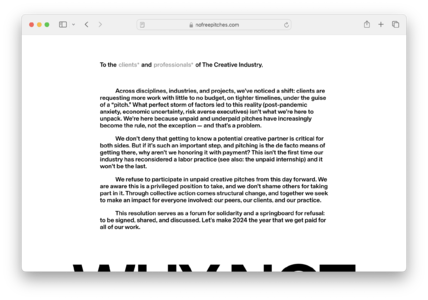
Nofreepitches.com, online petition signed by studios and creative individuals from all over the world
I’ve just signed it! I was reading it at the same time and I agree with everything. Free pitches are creating a very dysfunctional system and I feel that the people who created that culture are the big agencies who could afford doing that.
Traditionally, the idea of pitching mainly comes from advertising. And pitching for a campaign for an idea and pitching for the type of work that we do - creating branding systems - is so different. It is almost impossible for us to solve complex brand system challenges without going through the proper process. There are so many other ways for us to showcase our capabilities. So it’s bad for both sides: for the studios and for the companies hiring. It’s not good for the industry as a whole.


Simon Descamps’ signature on Nofreepitches.com, online petition signed by studios and creative individuals from all over the world including
Talking about pitches, PR and you handling your communication yourselves, I’ve realized as well that, at least on Instagram and your website, there’s little incarnation of you. Is it a conscious choice?
That’s interesting because I feel like we are pretty present, our photos, we are also on stage a lot. And the name of our company of course, PORTO ROCHA, which is our last name combined — It feels like old school advertising, or an European fashion label, our names are on the door.
FR
It’s almost like a joke because the name sounds very proper and corporate and we are not.
LP
It goes back to what I was saying earlier, it started as just us two but PORTO ROCHA is way more than just Felipe and I. we are a group of 30 people now, and PORTO ROCHA is really the combined voices of all of these people and the combined perspectives of people coming from different places, countries and backgrounds coming together to do great work together. So that’s why we are not as present, although I do think we are still quite present.
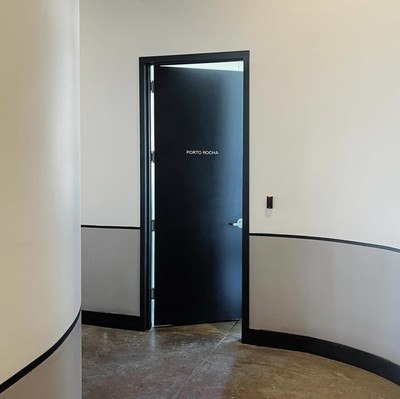
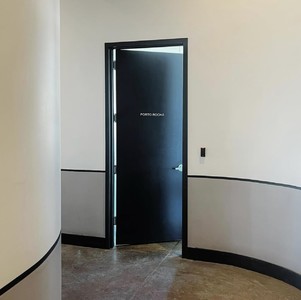
PORTO ROCHA front door, Brooklyn, NY

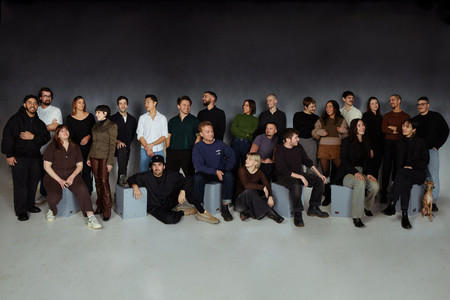
PORTO ROCHA team, 2024
There’s your presence in a way, but there’s no personal branding strategy that you could expect from someone from an agency with their own names. When you have the names of the founders, they have a tendency to put their portraits everywhere. It can be a business strategy and it’s often a very conscious choice, but it doesn’t seem to be like that for you.
Putting too much focus on our image as “the face” of the studio would go against our philosophy, the way our teams work and the way we approach creative challenges. We don’t support the old school work structure of a single design “mastermind” dictating direction or calling all the shots. We believe in collaboration over hierarchy and we are against this notion of glorifying design heroes and glorifying figures that become almost bigger than themselves.
FR
I feel like, in more traditional agencies, there’s often such a gap between the leadership, the founders, and the employees. It’s almost divided into different groups with the bosses having their own room. I think being part of one single group is what makes the most sense for us to feel truly integrated.
Because you were not trained to become managers of 28 people, how did you learn? How did that develop? What do you delegate in terms of management? Is that still Nick doing management?
I think we learned with good and bad experiences that we had in the past.
One thing I always say is that in five years, we went from two people to three, then five, eight, ten, twelve, fifteen, twenty, and eventually thirty. At each of those stages, we faced completely different challenges. When it was just the two of us, we had our own struggles, but as we grew, these early challenges went away—but new kinds of challenges emerged. For example, a super horizontal structure worked well when we were around seven or eight people. But as we approached fifteen, we realized we needed more structure to avoid redundancies. People wanted clearer organization and leadership—they needed to know who to report to. That’s when we had to learn to delegate, which was a big shift from our freelance days, where we controlled everything.
As graphic designers ourselves who are really annoying about every detail, letting go was tough. We had to trust that our team would get there, even if it took time. There’s always a learning curve people will go through, and at first, it can feel counter productive. But the most rewarding part is seeing the team become autonomous. It’s like that classic dilemma: you can either spend time teaching a junior designer and let them figure it out, or you can just ask for the files and do it yourself. But if you don’t take that leap of faith—if you don’t have patience and let the team learn by doing—you’ll never be able to grow.
What are the latest challenges now that you’ve got this quite big size of nearly 30 people?
I have one that comes to mind, which is the fact that because we are relatively big, we have a high monthly expense. So there’s a constant pressure in the air. Today our income model is entirely project by project. We don’t have any retainers or any guaranteed fixed income. We have to make sure we are constantly landing those big projects that are going to be able to help us pay all of our employees and all of our bills. And doing that without compromising the kind of work that we like to do with good clients, good companies, good people, and good creative challenges is the toughest thing. And on the other hand, taking on smaller projects that don’t pay the bills, which is something that we have always done and will continue to do in the future.
FR
I think for me, the biggest challenge is not a challenge that is isolated to us, it’s just the challenge of just the industry as a whole, that talking with other studios, other people running their own business, they feel the same. The timelines are shorter. Budgets are tighter. We are trying to adapt to whatever is happening in the world and here in the US. Things are changing fast and we have to try to keep up with it all.
LP
Right, everything is moving faster than ever so there is a constant sense of urgency and at the same time less certainty and less permanence as the world changes faster than ever. A rebrand was supposed to last 10 years, now we see brands doing refreshes more frequently, though the changes are often less significant.
FR
Especially clients in tech, web3, particularly AI, where technology is moving even faster, there is a high demand for rapid turnaround. This creates challenges for those in the field, as processes are compressed, and the quality of the work can end up compromised. Which is why we try to negotiate and find a good balance between the two sides.
You also mentioned that you wanted to be surrounded by young talents because they have new practices as well. What do you notice changes in young designers arriving on the market?
On the one hand, it is about understanding this upcoming generation’s way of thinking, what is meaningful to them and how they behave. The other side is about being in touch with new technologies, software and tools. Having the willingness to look at things differently and not to have that sort of resistance to sticking to the way things were done before. When we opened PORTO ROCHA we didn’t have Figma, which is crazy to think about. Or new softwares like Touch Designer, creative coding, and of course AI tools.
FR
And I think there’s also that perception that a lot of people have of younger generations - like Gen Z - saying they work less, they have a different relationship to work for example. I don’t think it’s that black or white. Maybe there is some sort of truth around that statement but at the same time, I think it’s for the best. This generation is probably being more vocal about problems and toxic behaviors that have dominated our industry for so long.
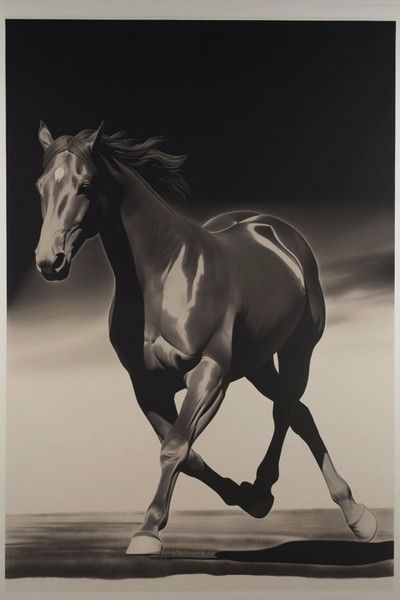
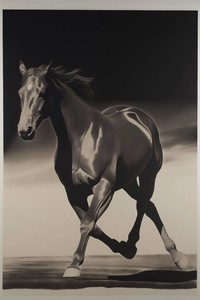
Running Horse, part of Swipe: an experimental AI Project by PORTO ROCHA
Any evolutions you’re thinking of for PORTO ROCHA? Are there any fields you would like to explore? Would you like to do other jobs at some stage? Would you like to integrate some new skills?
For sure. I think Felipe touched on this already, but we want to do more work in fashion. We want to continue doing more work in arts and culture, which is something that 2024 was great for us. We are designing two major museums, which is really exciting, but we want to continue doing that.
FR
Yes — one of them is MASP, the most important modern art museum in São Paulo, Brazil. And it’s a super important moment for them because they are going through this expansion: at the moment, their building can only welcome 500,000 visitors per year. And with this new expansion, they’re going to have up to 2 million visitors, which will put them in the list of the most visited museums in the world. And it’s this super iconic building designed by Lina Bo Bardi, one of the most important architects from Brazil. It’s amazing because we used to go there growing up.
And the other one is technically not a museum, it’s Kunsthalle Basel which is one of the most important art institutions in Switzerland. And again, going back to what I just said in the beginning, when I moved to Europe, I was always comparing myself with other Swiss designers, European designers. So in a way, I think it’s a full circle moment to be invited to rebrand a prestigious Swiss art institution.
LP
We are hoping the Swiss won’t get mad at us when they find out, like “what are these Brazilians doing here?”.

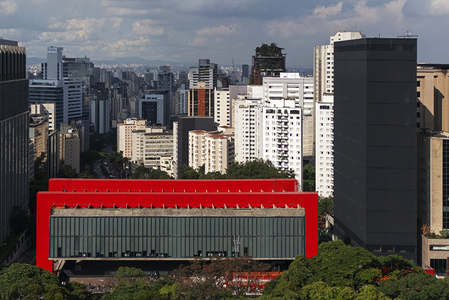
Museum of Art of São Paulo, Photography Leonardo Finotti
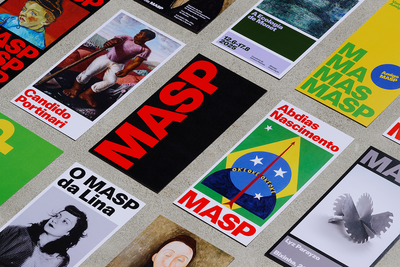
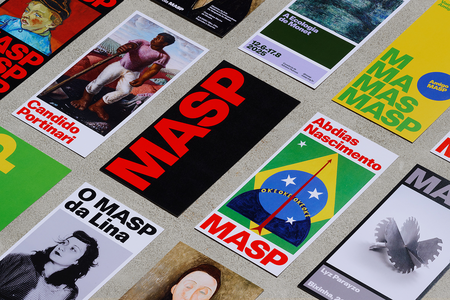
MASP Museum Printed Collateral, Photography Mari Juliano

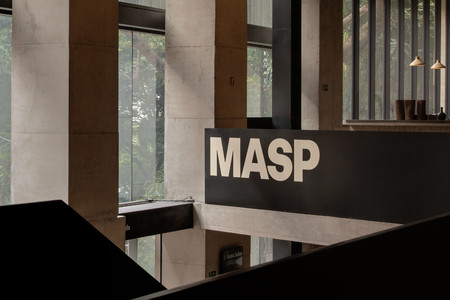
MASP lobby, Photography by Naira Mattia

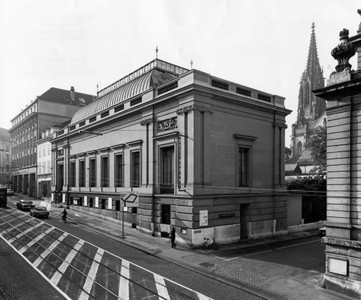
Kunsthalle Basel Building, Basel
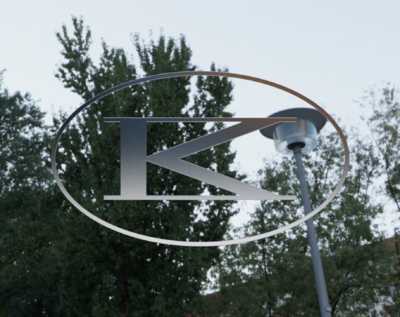
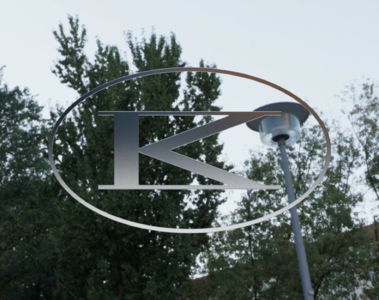
Kunsthalle Basel Symbol in 3D
In conclusion, I’ve got some more trivial questions: if you could do another job at another time, another historical era, what would it be?
I always like to say that if there wasn’t any homophobia in Brazil, I would have pursued a career as a dancer when I was a child. At some point in my life, as I grew up, I had to hide that. And maybe that’s the reason I went into design. It was a way to express my creativity, but it was not as gay. So I think I would probably be a contemporary dancer in another life.
LP
I really struggle with that question because design did come naturally. Maybe this sounds like an obvious or cliche answer, but sometimes I think about pursuing photography, which is something I explored when I was a teenager. And then I stopped for some reason. And sometimes I ask myself: what if I had continued? Where would I go with that? But maybe it’s never too late and I can still dive into photography and explore that side as well.
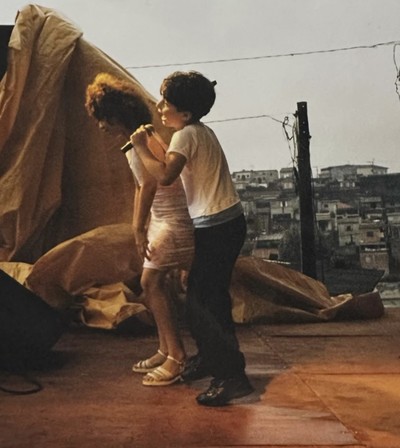
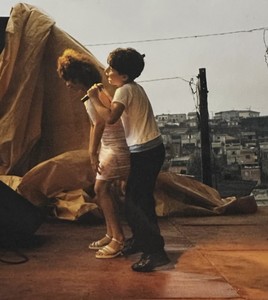
Felipe Rocha dancing with his friend on stage, Jardim Sapopemba - São Paulo
Coming from a design and graphic design background, are you both equally interested in photography, or do you have different reasons for your interest? What’s your relationship to photography, to image?
I’ve always loved photography, but what I love is the visual aspect. When it comes to the technicality of it, I think I’m less interested. I used to work at Colors magazine, which is a photography magazine in a way. I’m very interested in the whole cultural and anthropological aspect of photography.
LP
I’m into candid documentary photography just as much as highly technical studio imagery. I love capturing moments that translate the feeling of an experience—in the case of documentary photography, appreciating and preserving fleeting moments—like the way light hits just right at an instant. On the other hand, I appreciate finding beauty in everyday things, like mundane objects photographed in their most heroic form.
FR
Not to go back to Colors Magazine, but Tibor Kalman is my favorite designer of all times because I think he was one of the first designers that were able to play a lot with juxtaposition, the idea of combining photography in different ways and telling stories through photography in a way that is universal and also critical at the same time. For me, that’s the most interesting aspect of photography.
Are there books which have helped you personally in any way?
On a personal level, when I just moved to New York, I read Just Kids by Patti Smith. It helped me a lot because I was going through a similar situation in my life. And funny enough, she talks about this studio where she used to work next to the Chelsea Hotel and coincidentally I was working in the same building, the same studio, reading the same book and going through a lot of similar things. And on a professional level, a few years ago I read The Politics of Design, a very interesting book for anyone who is starting in the field. Just to be much more self aware of what we produce, the fact that everything we do has a consequence, being more critical about our influence in the world.
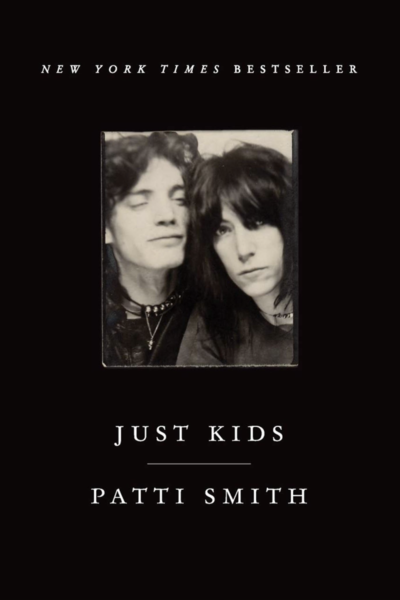
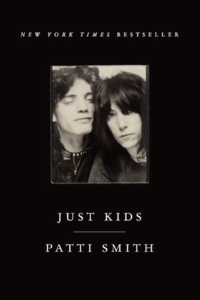
Just Kids by Patti Smith
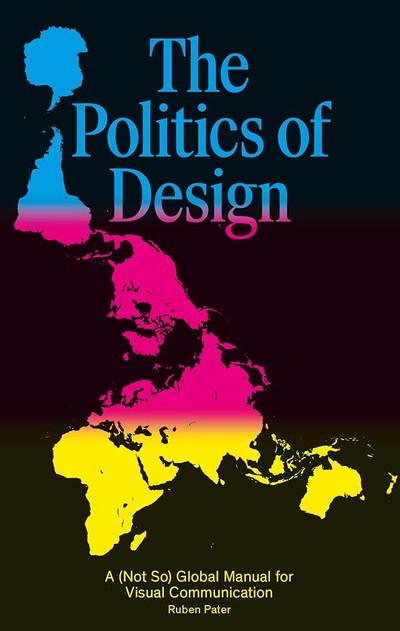
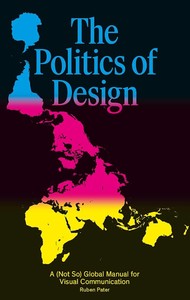
The Politics of Design by Ruben Pater
Is there an artist or someone who has helped you along the way, that could be a teacher, that could be a coach?
I have to say all of my professors at the School of Visual Arts were instrumental. I was lucky enough to study with Natasha Jen, Brian Collins, Paul Sahre, Carin Goldberg, Joe Marianek and Dinah Fried — among others. In many ways they helped me develop a more critical and strategic perspective on how we can apply design in the world. They also opened up a lot of doors in New York, into this industry that’s quite difficult to break into. Without my college professors, I think I would have had a much slower start to my career so that’s a big privilege I had, it was like a kickstart to my career.
FR
I don’t have anyone in particular. As I said before, I think Tibor Kalman as a designer was always looking up, especially after I started working at Colors Magazine. And also, especially after moving to New York, I became much more interested in Brazilian design. I feel there’s that classic sentiment that when you are far from home, you start feeling more connected to your roots. And then, one of my main interests in design is researching more about Brazilian designers and artists. And learning about other designers from Brazil that often have to work under not the best conditions but doing great work while they don’t have all the resources around them.
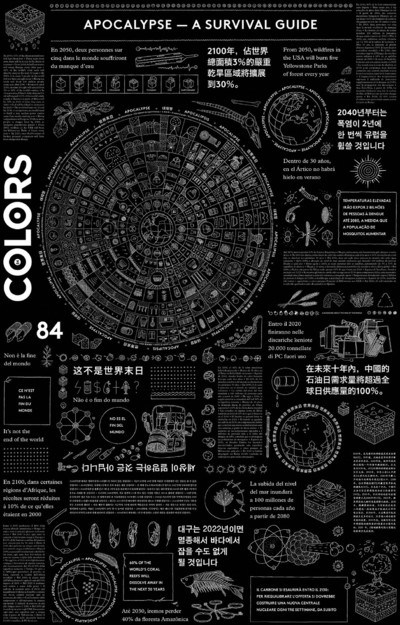
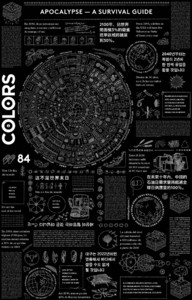
Poster from Colors Magazine #84: Apocalypse designed by Felipe Rocha
The last question is just one simple piece of advice you would give to young creative talents starting their career or potentially starting a studio which might become an agency.
I already talked about it but I think my work got so much better when I understood that even if I wanted to look like the classic European Swiss designer, I would never be that person. Or even when I started working with Stefan Sagmeister and Jessica Walsh, for a long time, I was trying to copy their style and I would always get frustrated because it was never representing my own work. I became much happier with myself and the result of my work when I understood that what is special about it is my background and where I come from.
LP
In the beginning of my career, I was very obsessed with design and I was just consuming a lot of design purely. There was a big shifting moment when I realized everything else besides graphic design is equally important to become a well-rounded graphic designer. It goes way beyond the technical and historical aspect of design as a discipline, it has to do with context, with intention, with being critical of the world and your choices, and applying all of these different perspectives into how you approach making those decisions. Every designer is different and every approach is valid, but I’m not interested in just sitting in a room with other designers that are like minded. To me, the full potential of design is to actually be in dialogue with the world and the people outside of our own discipline — we are communicators, connectors and curators. And the other thing I would say is just to take care of yourself. We talked about this too, the younger generations are doing a much better job at that. Of course you have to work really hard, but it is also important to establish those limits and understand that the notion of urgency is relative. A lot of times having the ability to prioritize is more important than saying yes to everything. Be willing to negotiate with yourself and with others.
